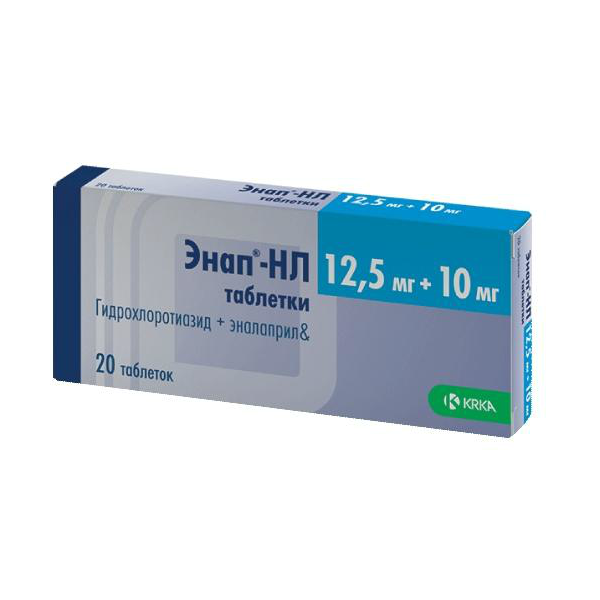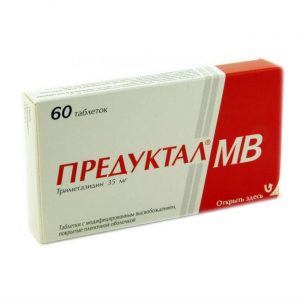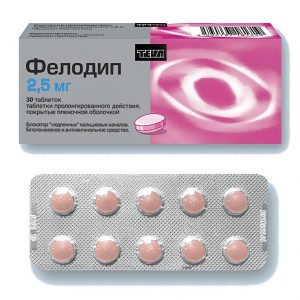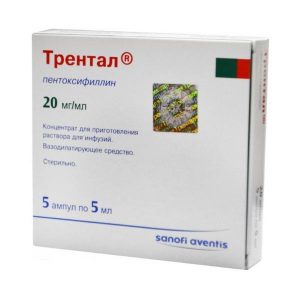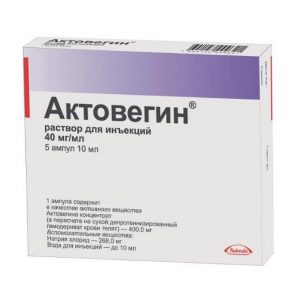Description
Release form
Tablets.
Packing
20 pcs.
Pharmacological action
Combined drug, whose action is due to the properties of the components that make up its composition.
Enalapril – an ACE inhibitor, is a prodrug: as a result of its hydrolysis, enalaprilat is formed, which inhibits ACE.
Hydrochlorothiazide is a thiazide diuretic. It acts at the level of the distal renal tubules, increasing the excretion of sodium and chlorine ions.
At the beginning of treatment with hydrochlorothiazide, the volume of fluid in the vessels decreases as a result of increased excretion of sodium and fluid, which leads to a decrease in blood pressure and a decrease in cardiac output.
Due to hyponatremia and a decrease in fluid in the body, the renin-angiotensin-aldosterone system is activated. Reactive increase in the concentration of angiotensin II partially limits the decrease in blood pressure. With continued therapy, the hypotensive effect of hydrochlorothiazide is based on a decrease in total peripheral vascular resistance. The activation of the renin-angiotensin-aldosterone system results in metabolic effects on the electrolyte balance of the blood, uric acid, glucose and lipids, which partially neutralizes the effectiveness of antihypertensive treatment.
Despite an effective reduction in blood pressure, thiazide diuretics do not reduce structural changes in the heart and blood vessels. Enalapril enhances the antihypertensive effect: it inhibits the renin-angiotensin-aldosterone system, i.e. angiotensin II production and its effects. Additionally reduces the production of aldosterone and enhances the action of bradykinin and the release of prostaglandins. Because it often has its own diuretic effect, this can enhance the effect of hydrochlorothiazide.
Enalapril reduces pre- and afterload, which unloads the left ventricle, reduces the regression of hypertrophy and proliferation of collagen, and prevents damage to myocardial cells. As a result, the heart rate slows down and the load on the heart decreases (in case of chronic heart failure), the coronary blood flow improves, and oxygen consumption by cardiomyocytes decreases. Thus, the sensitivity of the heart to ischemia decreases, and the number of dangerous ventricular arrhythmias also decreases. It has a beneficial effect on cerebral blood flow in patients with arterial hypertension and chronic cardiovascular diseases. It prevents the development of glomerulosclerosis, supports and improves renal function and slows down the course of chronic kidney diseases even in those patients who have not yet developed hypertension.
known that the antihypertensive effect of ACE inhibitors is higher in patients with hyponatremia, hypovolemia and elevated serum renin, while the effect of hydrochlorothiazide is not dependent on serum renin. Therefore, the simultaneous administration of enalapril and hydrochlorothiazide has an additional antihypertensive effect. In addition, enalapril prevents or weakens the metabolic effects of diuretic therapy and has a beneficial effect on structural changes in the heart and blood vessels.
The simultaneous administration of an ACE inhibitor and hydrochlorothiazide is used when each drug individually is not sufficiently effective or monotherapy is carried out using the maximum dose of the drug, which increases the incidence of adverse effects. This combination allows you to get a better therapeutic effect with lower doses of enalapril and hydrochlorothiazide and reduce the development of unwanted effects.
The antihypertensive effect of the combination usually lasts for 24 hours.
Contraindications
Hypersensitivity to the components of the drug.
Hypersensitivity to sulfonamides.
anuria.
Severe renal impairment (creatinine clearance (QC) <30 ml / min). Hereditary or idiopathic angioedema. Angioneurotic edema associated with the use of ACE inhibitors (history). Primary hyperaldosteronism. Addison’s disease. porphyria. Children and adolescents under 18 years of age (efficacy and safety not established). Precautions: Bilateral renal artery stenosis. Stenosis of a single kidney artery. Impaired renal function (CC 30-75 ml / min). Severe stenosis of the aortic orifice. Idiopathic hypertrophic subaortic stenosis. ischemic heart disease. Cerebrovascular disease (including cerebrovascular insufficiency). Chronic heart failure. Severe autoimmune systemic diseases of the connective tissue (including SLE, scleroderma). Inhibition of bone marrow hematopoiesis. Diabetes mellitus. Hyperkalemia. Condition after kidney transplantation. Severe impairment of liver and / or kidney function. Conditions accompanied by a decrease in bcc: As a result of diuretic therapy. While limiting salt intake. Diarrhea. Vomiting. Gout. Elderly patients. Special instructions A significant increase in serum calcium levels may be a sign of latent hyperparathyroidism. Some patients may experience hyperuricemia or worsening gout as a result of hydrochlorothiazide. If there is an increase in the concentration of uric acid in the blood serum, treatment should be discontinued. It can be resumed after normalization of laboratory parameters and in the future, carried out under their control. Caution when using the drug is necessary in all patients receiving treatment with oral hypoglycemic agents or insulin, since hydrochlorothiazide can weaken, and enalapril enhance their effect. Patients with diabetes should be observed more often, a slight change in the dose of hypoglycemic agents may be required. When angioedema of the face or neck occurs, treatment withdrawal and prescription of antihistamines are usually sufficient. In more severe cases (swelling of the tongue, pharynx and larynx), angioedema is treated with epinephrine, airway patency is supported by intubation or laryngotomy. The antihypertensive effect of Enap-NL may be enhanced after sympathectomy. Due to the increased risk of anaphylactic reactions, Enap-NL should not be prescribed to patients undergoing hemodialysis using polyacrylonitrile membranes undergoing apheresis with dextransulfate and immediately before the procedure for desensitization to aspen or bee venom. During treatment with Enap-NL, hypersensitivity reactions may occur in patients without prior allergies or bronchial asthma. Worsening of SLE during treatment with ACE inhibitors has been reported. Caution is also necessary in patients taking sulfonamides or oral hypoglycemic agents from the sulfonylurea group due to possible cross-sensitivity. Periodic monitoring of white blood cell count is required during treatment, especially in patients with connective tissue or kidney disease. In patients who received arterial hypotension medications during general anesthesia or after extensive surgeries, enalapril can block the formation of angiotensin II, which is secondary to the compensatory release of renin. If the doctor suggests this mechanism of arterial hypotension, treatment can be carried out by increasing the BCC. During treatment, periodic monitoring of serum concentrations of electrolytes, glucose, urea, creatinine and the activity of liver enzymes, as well as urine protein, is necessary. Treatment with Enap-NL should be discontinued before conducting parathyroid function tests. Influence on the ability to drive vehicles and control mechanisms Enap-NL does not affect driving or working with mechanisms, however, in some patients (mainly at the beginning of treatment) hypotension and dizziness may occur, which reduce the ability to drive and work with mechanisms. Therefore, at the beginning of treatment, it is recommended to avoid driving, working with machinery, and performing other work requiring attention until a response to treatment is established. Composition Active ingredients: Enalapril maleate 10 mg. Hydrochlorothiazide 12.5 mg. Excipients: Sodium bicarbonate, lactose monohydrate, calcium hydrogen phosphate (anhydrous), corn starch, talc, magnesium stearate. Dosage and Administration Treatment of hypertension should not be started with a combination of drugs. Initially, adequate doses of the individual components should be determined. The dose should always be selected individually for each patient. Take the drug regularly at the same time (preferably in the morning). The tablets are swallowed whole during or after a meal with a small amount of liquid. The usual dose is 1 tablet / day. If you miss the next dose of the drug, you must take it as soon as possible if there is a sufficiently large amount of time left before the next dose. If several hours are left before taking the next dose, you should wait and take only it. Do not double the dose. If a satisfactory therapeutic effect is not achieved, it is recommended to add another drug or change the therapy. In patients undergoing diuretic therapy, it is recommended to cancel treatment or reduce the dose of diuretics at least 3 days before the start of treatment with Enap-NL to prevent the development of symptomatic hypotension. Before starting treatment, kidney function should be examined. The duration of treatment is not limited. Use for impaired renal function: Patients with creatinine clearance> 30 ml / min or serum creatinine <265 µmol / L (3 mg / dl) may be given the usual dose of Enap-NL. Side effects of the From the cardiovascular system: Heartbeat, various heart rhythm disturbances, marked decrease in blood pressure, orthostatic hypotension, cardiac arrest, myocardial infarction, cerebrovascular stroke, angina pectoris, Raynaud’s syndrome, necrotizing angiitis. digestive system: Dry mouth, glossitis, stomatitis, inflammation of the salivary glands, anorexia, nausea, vomiting, diarrhea, constipation, flatulence, epigastric pain, intestinal colic, ileus, pancreatitis, liver failure, hepatitis, hepatitis, . From the respiratory system: Rhinitis, sinusitis, pharyngitis, hoarseness, bronchospasm, asthma, pneumonia, pulmonary infiltrates, eosinophilic pneumonia, pulmonary embolism, pulmonary infarction, unproductive dry cough, respiratory distress syndrome, including pneumonitis and pulmonary edema. From the side of the central nervous system and peripheral nervous system: Depression, ataxia, drowsiness, insomnia, anxiety, nervousness, peripheral neuropathy (paresthesia, dysesthesia). From the urinary system: Oliguria, renal failure, impaired renal function, interstitial nephritis. From the reproductive system: Gynecomastia, decreased potency. On the part of the sensory organs: Impaired vision, impaired taste, impaired smell, tinnitus, conjunctivitis, dry conjunctiva, lacrimation. From the hemopoietic system: Leukocytosis, eosinophilia, neutropenia, leukopenia, agranulocytosis, anemia, hypoglobinemia, pancytopenia. Metabolism: Hypokalemia, hyperkalemia, hypomagnesemia, hypercalcemia, hyponatremia, hypochloremic alkalosis, hyperglycemia, glucosuria, hyperuricemia, hypercholesterolemia, hypertriglyceridemia, increased activity of liver enzymes, hyperbillirubinemia. Dermatological reactions: Sweating, rash, herpes zoster, alopecia. Allergic reactions: Urticaria, pruritus, pruritus, skin rash, exfoliative dermatitis, toxic epidermal necrolysis, erythema multiforme, Steven-Johnson syndrome, photosensitivity, hypersensitivity reactions (angioedema, thrombocytopenic purpura), anaphylactic. Other: Weakness, fever, lupus-like syndrome described in the literature (fever, myalgia and arthralgia, serositis, vasculitis, skin rash, increased ESR, leukocytosis, eosinophilia, positive test for antinuclear antibodies). Overdose If you take too many tablets at one time, you should call your doctor immediately. Symptoms: increased diuresis, marked decrease in blood pressure with bradycardia or other disorders of the heart rhythm, convulsions, paresis, paralytic ileus, disorders of consciousness (including Coma), renal failure, impaired KSH, impaired electrolyte balance of blood. Treatment: The patient is placed in a horizontal position with a low head. In mild cases, gastric lavage and ingestion are indicated. In more serious cases, measures aimed at stabilizing blood pressure are shown: in / in the introduction of saline solution, plasma substitutes. It is necessary to control the level of blood pressure, heart rate, respiratory rate, serum concentration of urea, creatinine, electrolytes and diuresis of the patient. If necessary – in / in the introduction of angiotensin II, hemodialysis (excretion rate of enalaprilat – 62 ml / min). Storage conditions Store in a dry place at a temperature not exceeding 25 ° C. Shelf life 2 years. Deystvuyushtee substance Gidrohlorotiazid, nalapril Pharmacy Conditions prescription Dosage form tablets Possible product names ENAP-HL 10MG + 12.5MG. No. 20 TAB. / KRKA / Enap-HL tab. 10mg / 12.5mg N20 Slovenia Enap-HL tablets 10 / 12.5 mg, 20 pcs. ENAP-HL TAB. 10MG + 12.5MG No. 20 ENAP-NL TAB. 12.5MG + 10MG No. 20 KRKA d.d. Novo mesto AO, Slovenia
